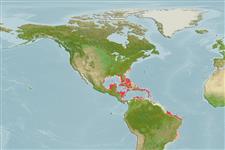Common names from other countries
Environment: milieu / climate zone / depth range / distribution range
экология
морской; солоноватоводный ассоциированный с рифами. Subtropical
Western Atlantic: Bermuda, Florida Keys (USA), and Bahamas to northern South America. Scarce in western Gulf of Mexico (Ref. 26938).
Size / Вес / Возраст
Maturity: Lm ? range ? - ? cm
Max length : 15.0 cm TL самец/пол неопределен; (Ref. 7251); 50.0 cm TL (female)
A very, slender, elongate, cylindrical eel with a projecting lower jaw. Lateral line complete ending at base of tail. (Ref. 26938).
Young and females burrow in sandy tide pools and reef tracts. Males inhabit deeper water, possibly pelagic. Adults emerge at night and sometimes come to lights at the surface (Ref. 26938). Feed on burrowing invertebrates that live in the sand (Ref. 26938).
Life cycle and mating behavior
Maturities | размножение | Spawnings | Egg(s) | Fecundities | личинки
Robins, C.R. and G.C. Ray, 1986. A field guide to Atlantic coast fishes of North America. Houghton Mifflin Company, Boston, U.S.A. 354 p. (Ref. 7251)
Статус Красного Списка МСОП (Ref. 130435)
CITES (Ref. 128078)
Not Evaluated
Угроза для людей
Harmless
Использование человеком
дополнительная информация
инструменты
Специальные отчеты
Скачать в формате XML
ресурсы в Интернет
Estimates based on models
Preferred temperature (Ref.
115969): 23.8 - 28.2, mean 27.3 (based on 786 cells).
Phylogenetic diversity index (Ref.
82804): PD
50 = 0.5003 [Uniqueness, from 0.5 = low to 2.0 = high].
Bayesian length-weight: a=0.00102 (0.00046 - 0.00225), b=3.06 (2.88 - 3.24), in cm Total Length, based on all LWR estimates for this body shape (Ref.
93245).
Trophic level (Ref.
69278): 3.5 ±0.37 se; based on food items.
Fishing Vulnerability (Ref.
59153): Moderate vulnerability (40 of 100).
